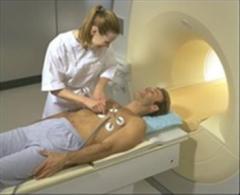- Author: Paul Kaufholz, Philips
- Contact details: paul.kaufholz@philips.com
The Guided patient positioning AdCoS of the Health domain of the HoliDes project provides guidance to operators of MRI scanner during preparing and positioning patients for MRI examinations. Correct positioning of the patient for the MRI examination and using the right coils and other devices is important to get good diagnostic quality images, but also important to avoid safety issues. Currently, operators are trained for this. The on-line guidance system intends to improve usability and to reduce risks, also in case of novice, less experienced users.

Figure 1: Pictures of several actions during patient positioning
An important way to provide guidance to the MR users is the use of a so-called “gantry display”, an interactive display attached to the scanner in the exam room as a means to provide guidance. The UI design on the gantry display to guide the user to prepare the patient has been iteratively improved based on user test feedback.
Based on feedback from (1) hospital observations to learn about the current way of working, (2) a card sorting exercise to discover what users find important in the workflow, and finally (3) a user test based on an iterated version of the UI design, a iterated design was created as depicted in Figure 2.
Multiple tools from the Human Factors – Reference Technology Platform (HF-RTP) have been used to support this AdCoS, especially tools provided by Work Package 5 (WP5) of the HoliDes project about “Empirical Human Factors Analysis Techniques & Tools” for usability-related activities such as task analysis and user testing. The WP5 tools Means-end analysis from Anywi, to analyse user needs, U-DAT from Philips, to capture user test results, in combination with HF-filer from Anywi, to generate a structured report, have been used in different stages. This allows for a more systematic concept validation and capturing of the results.

Figure 2: Iterated UI design
The output in several steps in the workflow can be translated as input to a tool supporting the subsequent step through an XML-based file format. This chaining of tools highly increases the efficiency and consistency of the usability results.

Figure 3: Chain of lifecycle tools for usability evaluations of the Guided patient positioning AdCoS

